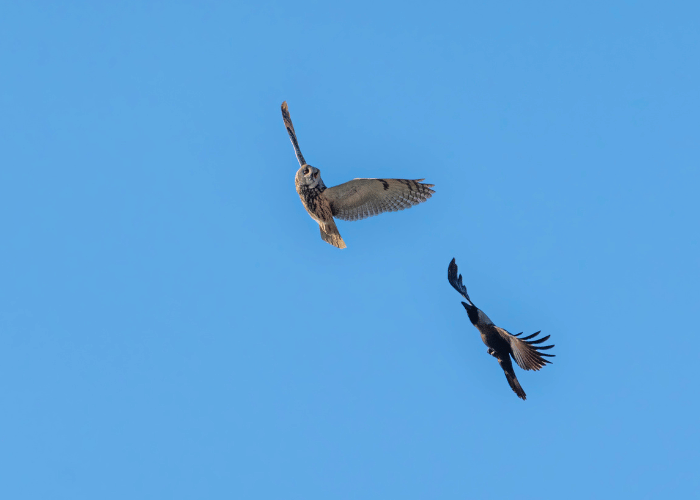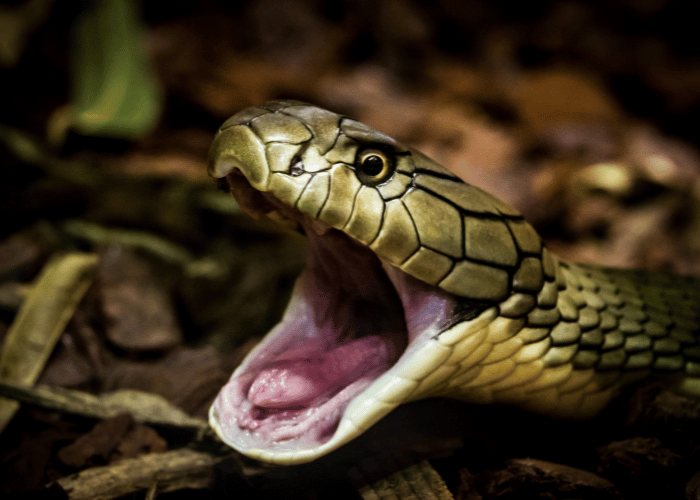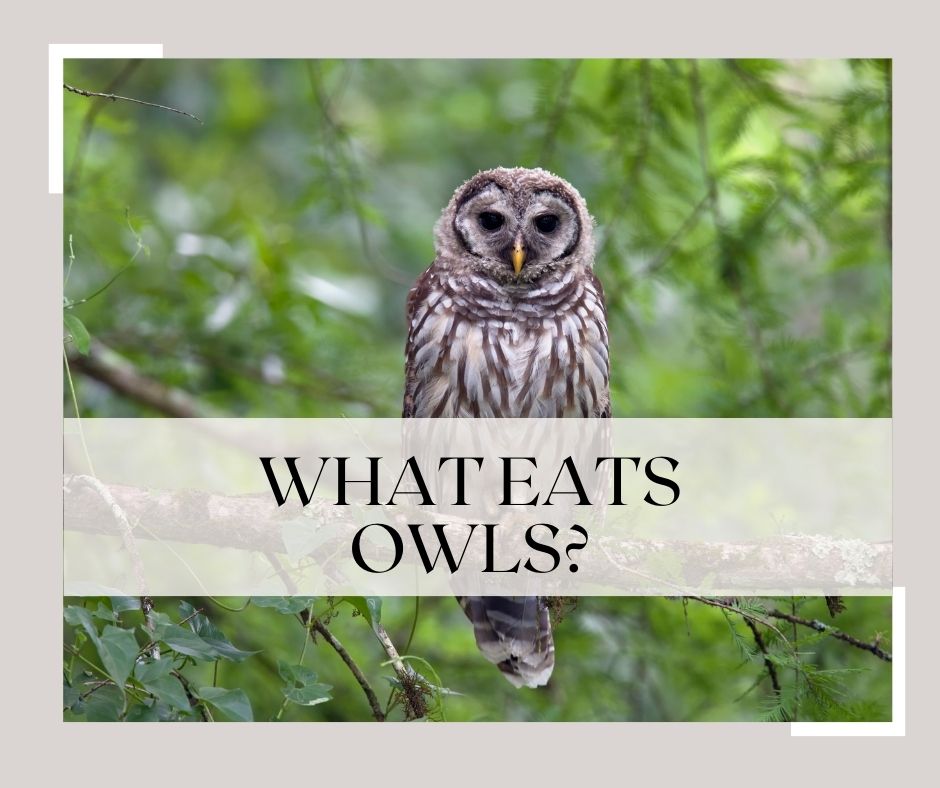What Eats Owls
Table of Contents
The circle of life is an immutable reality of nature. Just as owls have their prey, they too find themselves on the menu for a variety of predators.
Indeed, it might come as a surprise, but even these majestic creatures can fall prey to other cunning predators. While owls are known for their stunning ability to hunt in the still of the night and their razor-sharp talons equipped to snatch prey, there are predators out there that have spotted vulnerabilities in these otherwise fearsome nocturnal birds.
Among these predators, you’ll find eagles, foxes, and even certain types of larger owls. From the skies to the forest floor, numerous creatures have developed the means to challenge these skilled hunters. That’s right, even the silent predator of the night skies isn’t always at the top of the food chain. Curious to know more? Let’s dive deeper into this fascinating facet of nature’s web of survival and sustenance.

What’s on an Owl’s Menu: Predators and Threats
Owls, those enigmatic creatures of the night, have a roster of formidable predators and threats they contend with. They might be renowned as apex sky hunters but still face dangers right from their infancy. They’re not atop the food chain!
You’ll find large birds of prey pose the biggest threat to owls, and prominently, the Great Horned Owl! Often feared as the ‘Tigers of the Sky’, they’re infamous for their predatorial prowess, and not even other owls escape their predation. You may be surprised to find out that other owl species, like Northern Goshawks and Eagle Owls, can also target their owl kin.
Moreover, you’ll discover snakes, weasels, and coyotes also on the offenders’ list. They usually strike while the owls are nesting or surprise them on the ground, a terrain where owls are not as adept defensively.
Here, take a peek at some numbers in this markdown table:
| Predator | Owl Species Most Affected |
|---|---|
| Great Horned Owl | Various Owl Species |
| Snake | Ground-nesting Owls |
| Coyote | Grounded or Injured Owls |
| Weasel | Nestling and Adult Owls |
If you’re thinking, what about humans? Are they a threat too? It’s astonishing but true. Humans can unintentionally prove hazardous to owls. Loss of habitat due to deforestation, collisions with vehicles, and accidental poisonings due to pest control measures are all contributors to owl fatalities.
But don’t be disheartened! You can play a role in mitigating some of these threats. Simple actions such as monitoring the use of rodenticides and maintaining safe driving speeds in areas known for owl populations can tremendously aid their survival.
Different owl species have varying lists of predators, but each faces a fight for survival from the moment they hatch. While their reputation as night’s fearsome hunters is undebatable, understanding the threats they face reveals a dynamic, challenging ecosystem. Knowing what’s on an owl’s menu gives you an appreciation for the amazing resilience these captivating creatures of the night display. Reflect on this the next time you spot an owl in the wild.
The Role of Eagles in Owl Diets
Eagles are we’ll discuss next, in the context of their impact on owl survival. As surprising as it may be, eagles are one of the many predators that feed on some owl species. Uncommon though it may be, it is a ruthless reality in the natural world.
Take the great horned owl as an example, a raptor that is often included in the diet of large eagles. If you glance at the food pyramid of the animal kingdom, you’ll see it’s not structured with exclusivity. It is more complex than a simple chain, and eagles, specifically larger species such as the golden eagle, make their presence deeply felt in an owl’s life.
Just so, the relationship between eagles and owls isn’t always one-sided. It’s impressive to note, juvenile and smaller species of eagles can often be at risk from dominant mature owls. It’s a fluid dynamic, dictated by factors such as size, location, and opportunity.
Here’s an interesting fact, Owls are not the primary food source for eagles – it’s more like an opportunistic arrangement. Owls make up a small percentage of an eagle’s diet. Check out the table below for a clearer idea:
| Eagle Species | Percentage of diet made up by Owls |
|---|---|
| Golden Eagle | 2% |
| Bald Eagle | 1% |
Eagles, having a broad diet, include everything from fish to rodents to other birds. Nevertheless, the impact they have on the owl population is significant, adding another layer to the intricate web of survival.
Remember, nature is intricate. In a big picture scope, owls and eagles are a part of an intertwined food web. The balance is delicate and each creature, predator or prey, plays a pivotal role. So, as you unpack the knowledge of ‘what eats owls’, don’t forget the remarkable way that things are interconnected in the wild.

How Foxes Impact the Owl Population
Let’s delve into the predator-prey relationship between foxes and owls. Understanding how foxes impact the owl population can help shed light on the bigger picture of interdependent wildlife ecosystems.
Foxes, especially red foxes, are known predators of owls. Juvenile and mature owls alike can fall victim to these cunning creatures. While owls have powerful talons and beaks that can help them fend off many potential threats, they’re not always able to evade quick and agile foxes.
Now you might be wondering, “How often are owls part of a fox’s diet?” It’s important to note that foxes are opportunistic feeders and their diet varies greatly based on factors like location, food availability, and season. While small mammals such as rabbits and mice often form the bulk of their diet, they won’t pass up a chance to grab an owl if the opportunity arises.
Here is a rough breakdown of what predominately makes up a fox’s diet:
| Food Item | Percentage |
|---|---|
| Small Mammals | 44% |
| Birds (Including Owls) | 10% |
| Insects | 30% |
| Amphibians | 6% |
| Reptiles | 4% |
| Other (incl. fruits and berries) | 6% |
Notice the relatively low percentage of birds in the fox’s diet? It emphasizes that while fox predation plays a role in controlling the owl population, it is not the primary factor. However, when other food sources diminish, particularly in harsh winters, the rate of bird predation can increse.
In addition, the rise of urban fox populations can pose a greater threat to owls. In these environments, more foxes are in closer proximity to owls, disruptively affecting their nesting and breeding cycles.
- Foxes can raid owl nests for eggs and juveniles
- Increased fox predation can affect owl breeding patterns
- Fox disturbances can lead to abandoned owl nests
Your appreciation for the intricate relationship between foxes and owls can enlarge your understanding of wildlife dynamics. To conserve and manage owl populations, it’s crucial to consider details exactly like these – showing just how everything in nature is interconnected.
Is There Any Truth to Snakes Eating Owls?
Turns out, there’s a surprising predator in the food chain that you might not expect: snakes. While it may seem like an odd pairing, it’s completely true that snakes are known to occasionally prey on owls.
Snake species like the Reticulated Python in Southeast Asia and the Diamondback Rattlesnake in North America are known to have an owl or two in their diets. And it’s not because they’re particularly picky eaters. For many larger snakes, owls are a conveniently-sized, nutritious meal that’s within their hunting capabilities.
Let us take a closer look at the numbers. According to a report published in Journal of Raptor Research, between 30 to 70% of juvenile Spotted Owls fall prey to predation. The data is as follows:
| Grey Owl Age | Percentage Preyed by Snakes |
|---|---|
| Juvenile | 30 – 70% |
| Adult | 5 – 20% |
It’s important to note that predation rates can vary according to region, snake species, and owl species. For instance, juvenile owls are typically more vulnerable to being eaten by predators, including snakes, compared to adults.
This predatory relationship may seem harsh, yet it’s part of the natural balance of the ecosystem. Predators help control populations, contribute to biodiversity, and ensure the health of their prey species by culling the weak or sick.
In conclusion, the notion of snakes eating owls might initially seem like a crazy element of a horror story. But nature has its unique ways. Amidst its complexity and occasional brutality, there’s a deep-seated balance and sense of order. Yes, there are snakes that do eat owls, as surprising as it may seem!

Understanding How Humans Influence Owl Mortality
Did you ever wonder, what eats owls? While it’s true that owls, like other birds of prey, have natural predators, it’s worth noting that humans also significantly influence owl mortality rates. Unfortunately, many of these influences aren’t positive ones.
A considerable threat to owls comes from human activities such as habitat destruction. Chopping down trees and managing forests for timber can lead to the loss of nesting sites. It’s crucial that you recognize much of the suitable owl habitat is rapidly disappearing due to deforestation and land conversion for agriculture and urbanization.
More alarming, perhaps, are cases of intentional killings. Some people kill owls due to superstition or fear, while others do so merely for sport. This human-induced mortality contributes significantly to the decline in owl populations worldwide.
There’s also the issue of accidental deaths. Road accidents involving owls remain a concerning factor. Most often these occur when owls swoop low across the roads in pursuit of prey, only to collide with oncoming vehicles. Similarly, owls can become entangled in barbed wire fences, leading to painful injuries or even death.
Here are some estimated statistics regarding owl mortality factors:
| Mortality Factor | Estimated Percentage |
|---|---|
| Habitat destruction | 40% |
| Intentional killings | 25% |
| Accidents | 35% |
Highlighting another factor, human-made toxins and pollutants also pose serious threats. Rodenticides used in pest control can indirectly harm owls when they feed on poisoned rodents. Pesticides used in agriculture bear a similar risk, causing serious health complications and weakening owl populations.
To summarize these points:
- Habitat destruction severely affects owl populations
- Intentional killings add to the decrease in numbers
- Accidents while hunting or flying lead to unnecessary loss
- Toxins and pollutants indirectly harm owls and endanger their survival
This sort of human influence on owl mortality is a call for more responsible actions. By understanding how each behavior affects these magnificent creatures, you can better appreciate the gravity of the situation and hopefully be inspired to contribute to their preservation.
Unraveling the Dangers Sharks Pose to Owls
Can sharks really eat owls? This might be what’s gnawing at your thoughts. It’s a riddle in the grand scheme of nature’s food chain. If you imagine owls flying around open seas and sharks suddenly leaping out of the water to catch their winged prey, that’s not quite how it works.
Despite the fantasy, the reality involves much subtler interactions. You must first understand that sharks being a danger to owls is a rarity. After all, owls reside in forests, grasslands, and deserts, while sharks stick to their watery domain.
Interestingly, the only real instance where a shark could pose danger to an owl is when they both contend for the same food source: fish. The owl is an opportunistic predator and does occasionally swoop down to snatch a fish. If an owl were to dip too low near a feeding shark, the shark, being a powerful and versatile feeder, might mistake the owl for prey.
While no extensive study currently quantifies the frequency of such interactions, anecdotal evidence seems to confirm its possibility, albeit rare.
- This unlikely predator-prey relationship only happens due to overlapping food sources.
- In such circumstances, the owl is not the shark’s main target; the fish is.
Let’s take these points apart for better comprehension:
───────────────
| Sharks | Owls
–|——-|——
Habitat | Ocean/Water Bodies | Forests/Grasslands/Deserts
Food Source | Fish & Marine mammals | Rodents, insects & casually fish
───────────────
When discussing owls being preyed upon by sharks, it’s truly a case of being at the wrong place at the wrong time. In this precarious scenario, the owl could potentially become an accidental meal despite the unlikely nature of the owl-shark dynamic.
It’s also crucial to note that not all species of sharks eat birds, and getting to see an owl-shark interaction is a rare spectacle most people would never witness.
Unraveling this enigma, a bottom line emerges: Sharks and owls do not typically interact. These shark-owl encounters might be considered an edge case of nature, shaped by food habits, geography, and pure chance.
Summing Up: Unmasking the Predators of Owls
We’ve arrived at the end of our journey, uncovering the surprising truth about what eats owls. It’s crucial to understand that these nighttime birds of prey aren’t invincible. They’ve got their own set of threats in their winged world.
Large birds often pose a significant threat to owls. You’d be amazed by the variety of birds that could spell danger for these famous nighttime predators. Among them are the Great Horned Owl, eagles, and even larger hawk species. They’ve all been known to target owls.
Here’s a quick look at the principal feathered foes of the owl world:
- Great Horned Owls
- Eagles
- Large Hawk Species
But it’s not just about birds. An often-overlooked fact is that terrestrial predators also pose a considerable threat. This might surprise you, but animals like cougars, bobcats, and even bears can bring down an owl if given the opportunity.
And for those owls that prefer a low-lying lifestyle, threats come from species such as raccoons, possums, and snakes. In such cases, the owl’s impressive flight skills may not be enough to ensure survival.
To make these statistics easier to comprehend, let’s delve into a concise table:
| Predator Type | Examples |
|---|---|
| Birds | Great Horned Owls, Eagles, Large Hawks |
| Terrestrial Predators | Cougars, Bobcats, Bears |
| Ground-based Threats | Raccoons, Possums, Snakes |
This isn’t a cause for alarm, though. Nature has devised its own balance, and it’s a part of that ongoing cycle of life. Predation helps control owl populations and contributes to maintaining diverse and vibrant ecosystems. So, you see, understanding owl predators is more than just trivia—it’s a peek into the intricate workings of nature itself.
In a nutshell, while the owl may be a fearsome predator, it’s not without adversaries. And it just goes to show you, in the animal kingdom, it’s always a case of survival of the fittest.






